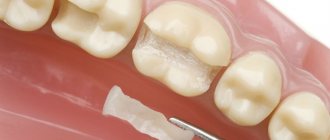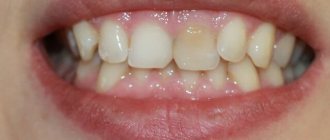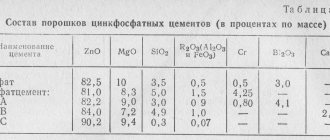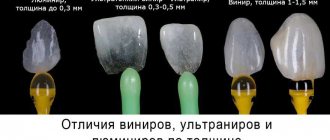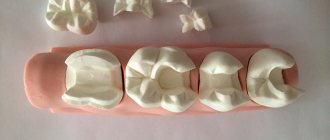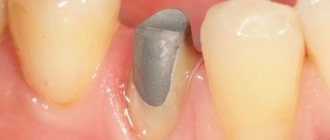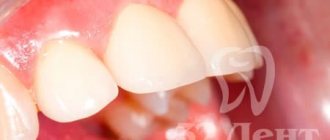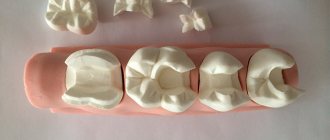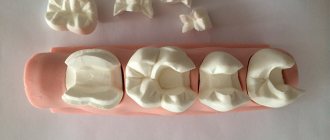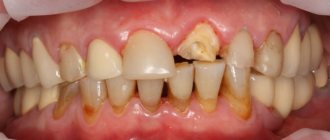Modern dental methods for restoring dental aesthetics will allow you to restore the beauty of your smile for many years quickly and painlessly. To eliminate extensive defects in the dentition, ceramic inlays are used on the tooth. In appearance, they are not much different from natural tooth enamel. With the help of the design, it is possible not only to restore the aesthetic characteristics of the units, but also to protect them from further destruction under the influence of caries and mechanical loads.
Ceramic inlays can last 10 years without shrinkage or deformation. They are created in special dental laboratories individually for each patient. The materials used to create structures are characterized by increased strength and resistance to external irritants. Installation of the tab takes place over several visits to the dentist (2-3 procedures). The cost of the dental procedure in question usually exceeds the price of a standard filling of decayed units.
What are they?
A ceramic inlay is a fragment that replaces the lost part of the teeth. They are designed to restore crowns that have been destroyed by more than 30%, and in cases where the use of conventional filling materials is not possible.
Products differ from each other in material of manufacture, production method and performance indicators. The inlay completely follows the shape and size of the teeth, protecting them from further destruction. The structure can be placed on both the external and internal sides of the teeth.
Flaws
Ceramic dental inserts have virtually no disadvantages. But there are still shortcomings. This is primarily a high cost compared to the price of installing a filling, which is explained by the high cost of the materials used and the complexity of manufacturing.
In addition, treatment with onlays is longer than with a conventional filling and may require several visits to the dentist.
Another disadvantage is the presence of contraindications for the use of overlays.
Indications and contraindications
The main indications for restoring the aesthetics of elements using structures:
- increased abrasion of enamel;
- severe mechanical damage to the crown of the tooth;
- destruction of the crown by more than 30%;
- the need to use the unit as a support for the prosthesis;
- using ceramic inlays instead of fillings.
The products are an improved version of fillings that are made to order. Installation of structures is not possible in all cases.
Contraindications for the procedure are:
- the need to restore milk elements;
- destruction of the crown by more than 60-70% (in this case, doctors offer crowns to patients);
- lack of a healthy root system of the tooth;
- serious mechanical damage to the unit, in which nothing remains of it;
- destruction of incisors or canines (inlays, as a rule, are not used for the restoration of these elements);
- progression of carious processes in the oral cavity.
Photos before and after installing a ceramic inlay
Experts also do not recommend restoring wisdom teeth using ceramic structures. Eights do not play any role in the process of chewing food and are invisible to others, so there is no point in spending money on their expensive restoration.
Contraindications for installing ceramic inlays
The emax tab also has some contraindications for installation. There are no absolute contraindications, but there are relative and temporary ones, which are recommended to be eliminated before installing a ceramic onlay. Among them, insufficient oral hygiene is the most common contraindication. In this case, a specialist performs professional cleaning and prescribes additional oral care methods that can be done at home.
In case of carious lesions of the teeth, the dentist carries out treatment, and after it proceeds to install the structure. Experts do not recommend installing onlays on the last molars (“eights”). They do not perform a chewing function, so in case of severe destruction, the easiest way is to completely get rid of them without spending time on restoration.
It will not be possible to carry out the installation if only one wall of the tooth remains (at least two remaining walls are required). Problems can arise when the cavity depth is insignificant (less than 2 mm) or the presence of pathological cavities that go deep into the dentin. For bruxism (teeth grinding), the installation of pads is not recommended, since they will quickly wear out, which will significantly reduce the service life. However, you can use a special device (night guard) that will prevent the teeth of the lower jaw from rubbing against the teeth of the upper jaw.
The difference between an inlay and a filling
Which is better: a filling or an inlay? The main distinguishing characteristics between the two types of products are discussed in the table below.
| Characteristic | Tab | Seal |
| Mode of production | Created indirectly in a dental laboratory using a three-dimensional model | Created directly in the patient's mouth |
| Production time | From several days to several weeks | One day |
| Number of visits to the doctor for installation | 2-3 visits, depending on the complexity of the clinical case | 1 visit for uncomplicated caries |
| Restoration zones | Chewable units | Any teeth |
| Quality of adhesion to enamel | Perfect | Shrinkage possible |
| Operating time | 7-10 years | 3-5 years |
Positive aspects of the products
The main advantages of using ceramic dental inlays are as follows:
- High aesthetic value that does not change over time.
- Full compatibility of prostheses with these products.
- High precision processing of the product, allowing it to come into maximum contact with the walls of the dental cavity.
- Tooth enamel hardly wears out.
- Possibility to prepare teeth for fastening crowns.
- Possibility of filling even large dental cavities.
- Resistant to dyes.
- No polymerization or shrinkage after installation.
- The products are much stronger and more durable than fillings. The strength of the installed material exceeds the strength of building bricks by 4-10 times.
- Preservation of the appearance of the dental organ and its functions when using them.
- They do not cause discomfort or the feeling of a foreign object being in the oral cavity.
Pros and cons of tabs
Ceramic inlays have a number of advantages compared to other methods of restoring teeth. The advantages of a ceramic tooth inlay include:
Veneers on teeth: pros and cons
- the ability to mask large cavities and destroyed fragments;
- no need to adjust the size of the product due to its exact fit (seals do not meet these criteria);
- no staining from food or changes in original external characteristics;
- minimal risk of developing allergic reactions due to the high biocompatibility of the materials of the inlay and the oral mucosa;
- stability and strength, which makes it possible to consume familiar food products, including hard ones (nuts, seeds, crackers);
- no discomfort during operation.
Inlays also have a number of disadvantages, among which patients highlight:
- long recovery period after the procedure;
- the need to wait for the production of products;
- high cost of restoration;
- the need for several visits to the clinic.
Reviews
Despite the high cost, ceramic inlays are very popular among patients in dental clinics, judging by the reviews.
This is due to their high quality, aesthetic characteristics and service life.
You can share your opinion about the use of ceramic microprostheses in the comments section.
If you find an error, please select a piece of text and press Ctrl+Enter.
Tags inlay ceramic inlay fixed dentures
Did you like the article? stay tuned
Previous article
Purpose of using turunda after tooth extraction
Next article
All the details of laser teeth removal
Kinds
There are 3 main types of inlays, which differ in material of manufacture, service life and cost. The modern type of material from which products are made is metal ceramics. Their cost is not much different from ceramic structures, but in quality they are significantly inferior to them. Cermet inlays may fall out when exposed to too high or low temperatures. This is due to the ability of the metal to expand under the influence of temperature factors. For this reason, dentists do not advise patients to resort to modern methods of dental reconstruction.
Inlays can also be made from pressed ceramics. Porcelain is used to produce structures of the required shape and size under the influence of high temperatures. As a result of laboratory work, inlays are durable and resistant to external influences. In terms of strength, they are not inferior to zirconium samples. Ceramic structures are recommended for use in cases of significant destruction of dental elements.
Zirconium is another material used to make inlays. The resulting products are in no way inferior to porcelain in terms of technical characteristics. They are turned on modern machines using pre-prepared plaster models. All stages of work are controlled automatically by high-precision devices.
It is allowed to use stump products to restore a completely destroyed coronal part, provided that the tooth root is preserved. After the procedure, a crown or bridge is attached to the tab
Depending on their purpose, structures are divided into restorative and stump. The former allow you to restore the integrity of the tooth crown with a healthy root system.
What kind of design is this
A ceramic dental inlay is a microprosthesis1 that restores the integrity of a tooth when it is less than half destroyed. Such microprostheses are called “restorative inlays”, and they are installed not by dental therapists, but by orthopedic dentists (“prosthetists”). Externally, ceramic masonry looks like a piece of your own tooth - more precisely, the missing area on a natural crown, with all the tubercles and grooves-fissures. When a microprosthesis is fixed, it, like the last piece of a “puzzle,” restores the integrity of the tooth.
The resulting restoration looks very natural – indistinguishable from a “native” tooth. This is due to the properties of ceramics, which are now produced using advanced technologies - with natural light refraction, translucency, color and transparency transitions in different areas of the ceramic.
Restorative microprostheses are often compared to fillings or even confused with stump inlays. Next, we’ll tell you how they differ – after all, these are still different concepts.
Complex on 4 OSSTEM implants with delayed loading - from RUB 170,000.
Complex implantation Osstem (South Korea) with delayed loading after 4-6 months.
Guarantee for the doctor’s work - unlimited Call now or order a call
Opening hours: 24 hours a day - seven days a week
Installation technique
Reconstruction of row elements using ceramic inlays occurs in stages:
- First, old fillings (if any) are removed. Teeth preparation occurs using a cooling system that prevents overheating of bone tissue. Grinding of the restored unit often occurs with the use of magnifying dental instruments (binocular glasses). Thanks to them, the doctor will be able to preserve a larger volume of healthy dentin tissue.
- After preparation, the resulting cavity is processed with a caries detector. The method allows you to identify the affected areas remaining after preparation.
- Precision grinding and smoothing of tooth edges with Arkansas stone. The steps of the procedure are necessary to ensure a good fit of the ceramic inlay.
- After this, an impression is taken from the problem unit, from which the dental technician will create an inlay. Checking the compliance of the parameters of the inlay with the resulting cavity is also carried out using binocular glasses.
At the last stage, the manufactured product is attached to the tooth. Various adhesives are used for this purpose. After installation of the structures, the patient will need to adhere to a number of rules in order to extend the life of the inlays.
Private clinics practice a new method of dental restoration using the Chairside technique, which allows you to restore the aesthetics of your smile in one visit to the dentist.
During the procedure, the dentist uses a device equipped with a three-dimensional camera. Powder is applied to the work area before taking the photo. This makes the image more accurate and clear. The 3D device transmits the resulting image to a large screen and uses it to calculate the parameters of the future tab. All data is transmitted to the grinding unit, which grinds the product. The procedure takes no more than 30 minutes.
Manufacturing and installation stages
Manufacturing and installation of an orthopedic structure is not difficult and does not take much time. At the initial appointment, the dentist examines the oral cavity to determine indications and contraindications for the procedure. If contraindications are identified, they are eliminated, after which they proceed to therapy. If necessary, endodontic treatment and hygienic treatment of the diseased tooth are carried out. By analogy with standard filling, the specialist removes all destroyed tissue from the tooth, forming an area for a microprosthesis. After this, a cast is made that exactly repeats its shape.
The production time for an emax ceramic inlay based on the impression obtained (3D modeling results) is about 5-10 days. At this time, a temporary filling material is placed in the patient's cavity. The onlay is made in laboratory conditions, taking into account the individual characteristics of the patient’s dental system. The orthopedic structure is fired and covered with layers of ceramics. At the secondary appointment, the patient’s temporary filling is removed and a finished microprosthesis is installed. It is attached using special cement, which firmly adheres to the ceramics and enamel of the tooth. This guarantees a secure fit. At the end of the process, the surface is polished. The whole procedure takes no more than 120-150 minutes.
Service life and care features
Dentists claim that the maximum service life of ceramic inlays is 5 years, but this time can be extended with proper care of the product. Many manufacturers offer a 10-15 year warranty on zirconia and pressed ceramic products.
In order to carry the tab as long as possible, you must:
- brush your teeth 2 times a day for at least 2-3 minutes;
- rinse the mouth with special solutions or water after eating;
- refuse actions associated with strong pressure on the jaws and closing them together;
- Visit the dentist at least once every 6 months.
Classification of recovery tabs
First of all, microprostheses are distinguished by size - i.e. what crown area do they restore? This leads to the following classification:
- inlay (“inlay”): this is a very small ceramic liner that is installed in the tooth cavity and does not affect the cutting cusps of the crown,
- onlay (“onlay”): this ceramic onlay is slightly larger in size, it restores the internal slopes of the cutting cusps of the tooth,
- overlay (“overlay”): the onlay can completely cover the upper part of the natural crown and also restore the outer slopes of 1-3 tubercles. But, at the same time, this is not a full-fledged artificial crown, but an analogue of its top.
- pinlay (“pinlay”): such an overlay is equipped with a “pin” or pin (it is also ceramic and is a monolith with a microprosthesis). The pin goes deep into the dentin layer and is necessary for better retention of the restoration in the dental cavity - because “Pinley” restores not only the cutting edge, but also the tooth wall. In some ways, pinlay can be compared to a veneer, only the veneer is placed on the front surface, and “pinlay” is placed on the lingual surface of the tooth.
Price
Let's consider the average cost of ceramic inlays in Moscow, depending on the material they are made of. The table also shows the advantages and disadvantages of each type of product.
| Material | Price | pros | Minuses |
| Metal based ceramics | 10-15 thousand rubles. | Increased strength due to the inclusion of a metal frame | High risk of falling out of the mouth |
| Pressed ceramics | 15-20 thousand rubles. | Relative strength, high aesthetic characteristics, long service life | Risk of chipping |
| Zirconium dioxide | 25-30 thousand rubles. | Natural appearance, service life up to 20 years | High price |
In the course of life, people often encounter the appearance of chips and cracks in their teeth. Ceramic inlays, which have undeniable advantages over the traditional filling procedure, will allow you to restore the aesthetics of the element. After the treatment, the patient will not need to comply with special conditions for oral care.
Possible complications
Fixation of the microprosthesis is accompanied by grinding down the surface of the tooth in order to remove tissue affected by caries.
With a highly professional dentist, this procedure does not cause problems, however, in some cases it can lead to the development of secondary caries - if the affected tissue or pulpitis is not carefully removed.
The increased sensitivity of the patient's teeth can lead to the fact that after installing a microprosthesis, at first there will be discomfort and a feeling of the presence of a foreign object in the oral cavity. Over time, this feeling will disappear.
In some cases, the patient may experience an opening of a cavity in the body of the tooth , which entails the loss of the inlay.
In this situation, you should immediately contact your dentist to re-fix the product or make a new microprosthesis.
How are inlays made?
All methods for making ceramic inlays are indirect – i.e. in a laboratory setting. Liquid materials for layering and subsequent baking techniques are rarely used as the main method. More often - for lining the frame of metal-free ceramics made of lithium disilicate or zirconium dioxide.
Also, ceramic microprosthesis can be made by injection molding. Another method (characterized by ideal anatomy and fit into the dental cavity) is the use of CAD/CAM systems. Here, the model of the future microprosthesis is first worked out in a computer program and then milled on a machine.
What stages are included in microprosthetics?
- preparation: the dentist removes the remains of the old filling or prepares enamel and dentin affected by caries, if necessary, treats and fills the root canals,
- taking impressions: impressions are taken not only from the causative tooth, but also from those with which it contacts or intersects. A more modern method is a 3D scan of the oral cavity, the parameters of which are entered into a computer program. Next, the patient is given a temporary filling for several days or weeks to protect the tooth from infection and damage.
- creation of a model: a physical model is created in the laboratory, which is tried on the patient (here you can make additions or adjustments to make an ideal microprosthesis),
- manufacturing: during the manufacturing stage, the final version of the ceramic inlay is created. To improve aesthetics, it can be painted, lined with ceramics, polished - so that the restoration takes on a natural shine and food coloring is not absorbed into the material,
- fixation of the finished ceramic inlay: for this it is recommended to use three-stage fixation materials, for example, the Syntac universal adhesive system from Ivoclar Vivadent.
The entire process of preparation, manufacturing, and adjustments may take 1-3 weeks (depending on the workload of the laboratory). Fixation occurs within 20-30 minutes, and here it is important to carefully remove the temporary filling, as well as treat the cavity with an antiseptic.
“Not long ago I got myself a ceramic filling, or rather an inlay. That's what the prosthetist called her. Looks very real, like your own tooth. But the downside is that it takes a long time to do it. And all this time you need to chew carefully. Otherwise, you can chip a tooth with a temporary filling. Then you’ll have to make new impressions and a new prosthesis, and pay again.” Artem I., review from otzovik.com
More examples
Example 1:
Here the tooth is cracked due to a large filling.
Example 2: filling with usual indications
Given:
Correct fillings:
Why is precision inlay design necessary?
For small interventions, manual precision work with fillings and additional correction is sufficient.
In large reconstructions, it is often necessary to restore the cusps on the teeth that ensure proper contact. We build an occlusal compass to model the oral cavity so that movements are limited, that is, to ensure the correct mechanics of teeth closure. It is basically impossible to do the same thing in the mouth using filling material. Yes, you can achieve aesthetics with fillings, but correct mechanics with large interventions with several teeth is almost never possible. When a filling is required not on top, but on the side surface of the tooth, it is necessary to restore the contact point (so that the thread passes with a click): this is necessary so that food does not pass down and injure the periodontal papilla. It is very difficult to restore the contact point with the correct anatomy. In addition to the contact point itself, there is an approximal ridge with a triangular fossa. He rolls the food bolus not between the teeth, but towards the chewing surface of the tooth:
On a filling it is often not easy to do this manually. And another difficulty is when we have a defect on the side, and it is critically important that the restoration or filling is level with the level of the tooth: if it is wider, then food will get there and there will be caries below. If already, there will be a step that will create mechanical difficulties.
Types and brands of ceramic materials
Types of ceramic inlays differ in materials. Since ceramics include not only porcelain (in the classical view, this is ordinary feldspar), but also ceramic raw materials with various additives - they are also called “metal-free ceramics”. Let's take a closer look at the materials used:
- feldspathic ceramics: usually these are liquid or plastic materials for layer-by-layer application and baking in a special oven, for cladding - i.e. to enhance the aesthetics of other materials. For example, the Shofu brand Vintage Halo, VITA VM 13 from VITA Zahnfabrik, IPS e.max Ceram. They have good aesthetics, but lower strength (40-60 MPa) compared to more modern materials. It is worth adding that feldspar in different concentrations can be added to different types of ceramics,
- nanoceramics: liquid raw materials containing submicron glass - for example, ceram.x Sphere TEC material from Dentsply Sirona. Can be used both for filling and for making microprostheses in the laboratory,
- leucite glass ceramics: contains leucite crystals, which give the ceramics strength (160 MPa) and translucency with a “chameleon” effect. Typically, manufacturers produce glass ceramics in 7-12 color and transparency options, which makes it universal for both young and elderly patients. Popular brands are IPS Empress Esthetic ET, IPS Empress CAD HT from Ivoclar Vivadent and VITABLOCS Mark II from VITA Zahnfabrik. The material is processed according to the principles of injection molding or milling using a CAD/CAM system, produced in the form of blocks or small cylinders,
- glass ceramics based on lithium disilicate: such glass ceramics have increased strength (470 MPa) and allow you to create aesthetic restorations regardless of the original shade of the tooth. The highest quality brand is IPS e.max Press HT from Ivoclar Vivadent. In general, "E.Max" is considered an advanced material for pressing technology,
- reinforced glass ceramics (based on lithium disilicate and zirconium dioxide): strengthened material (more than 500 MPa) containing 10% zirconium dioxide. For example, Celtra Press and Celtra Duo from Dentsply Sirona, which are primarily suitable for inlay and onlay restorations,
- hybrid ceramics: ceramic-polymer properties give the material strength and elasticity - the ability to absorb chewing loads without destroying the structure (VITA Enamic T, HT, ST brand),
- zirconium dioxide: the most durable material (up to 1400 MPa), which belongs to metal-free ceramics. It is processed only by milling (we will discuss the methods below). Many manufacturers produce zirconium dioxide only in white, but the most progressive ones have learned to color it in natural shades. Popular brands – IPS e.max CAD, Prettau Zirkon from Zirkonzahn.
What else do you need to know about tabs?
The ceramic products themselves will be found unchanged at the excavations of your home.
Most likely, your remaining teeth will degrade, but the inlays will remain the same. But the material that creates micromechanical connections with the hard tissues of the tooth degrades and accumulates mechanical fatigue. Research is currently underway to improve its qualities. Of importance, composites based on glass ionomer cements have long been widely used. They are very friendly to dentin and release fluoride, which is a cellular poison for bacteria. It is impossible to make a filling entirely from such cements: it will be mechanically unstable and of poor aesthetics. We use this material if there are deep cavities or if we are concerned about possible inflammation of the pulp. We place a layer of this material under the inlay: the overall result is a structure that is good in relation to tooth tissues and is quite stable, capable of withstanding loads. Glass ionomer cement alone cannot withstand loads without an inlay. Inlays protect against hidden tooth defects. If a tooth with a filling cracks, this often means almost the same type of damage as when triplex glass is damaged: the fracture site and many microcracks are visible. Many of them are difficult to track, but in general the material is degrading. If such cracks reach the root, they become a gateway for infection and cause a purulent inflammatory process. This means much more complex consequences, including rapid loss of bone tissue: a defect is formed in the bone tissue, and then there is nothing to put an implant into. We will have to remove the tooth, augment it with xenogeneic bone or mixed with autogenous material.
From scanning to the finished restoration, the patient waits at least 40 minutes - this is design and milling. In complex cases, this is two hours; the median case in the clinic’s practice, taking into account cavity preparation, is about 90 minutes. An inlay for one tooth costs from 44,000 rubles, while a filling for one tooth costs from 9,000 rubles.
PS If you come to our clinics, then say that you are from Habr, there will be a 5% discount.
Aftercare
There are certain recommendations that you need to follow after installing the tab. First of all, we are talking about regular brushing of your teeth, and this should be done not for 30-40 seconds, but for at least 2 minutes. It is recommended to use mouthwash after every meal. Heavy loads, including exercise in the gym, should be avoided. The fact is that under such loads a person strongly clenches his jaws, which is why the teeth are subjected to strong mechanical stress.
Inlays for teeth can be used in dental practice not only separately, but also in tandem with other elements and structures.
As a result, it is worth noting that this type of installation of microprostheses is one of the most common methods of tooth restoration. Even in the most severe cases, when the tooth is almost completely destroyed, it can be restored in such a way that the dentition looks as aesthetically pleasing as possible. The patient will not suffer from the unpleasant sensations that people often have to face after installing dental fillings and other restorative procedures.
